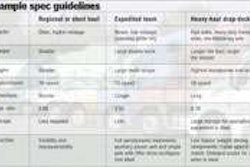4 keys to maximizing your loads
Most owner operators focus primarily on two factors when deciding which load to haul: mileage pay rate and length of haul. However, you shouldn’t care much about gross revenue, but rather how much of that revenue you get to keep after expenses.
For example, when comparing loads, most operators gravitate to the higher mileage pay and the longer length of haul. But there are more factors to consider. Here are four of the top ones:
FIXED COSTS PER DAY

If you choose to pass up a low-paying load and sit for a day, be aware that you will lose this amount. This also means the load you eventually choose needs to pay enough to cover the fixed cost of sitting.
FUEL COST PER LANE


Take that one step further and look at geography and terrain. If you average 6 mpg, then you will more than likely be able to achieve only 5.5 mpg on a run from Los Angeles to Denver, but 6.5 mpg from Houston to Mobile, all because of terrain differences. If you recalculate your cost per mile, you’re paying 56 cents per mile on the West Coast load and 43 cents per mile along the Gulf. That difference of 13 cents per mile might more than compensate for a smaller rate spread.
BACKHAUL RATE AND LOAD AVAILABILITY

A search revealed I had a choice of 129 loads out of Dallas but only 43 loads out of Denver, and rates were much better from Dallas. If you are going to a destination with little load availability, make sure you consider deadhead cost to get to the next load.
LOAD WEIGHT

Not every one of these factors can be applied to every situation. But the more you study rates and lanes and understand how they affect bottom line profit, the better you will become at choosing the most profitable loads.

Kevin Rutherford is an accountant, small-fleet owner and the host of “Trucking Business & Beyond,” which airs on Sirius XM Radio’s Road Dog Trucking Radio. Contact Rutherford through his website, www.LetsTruck.com.











